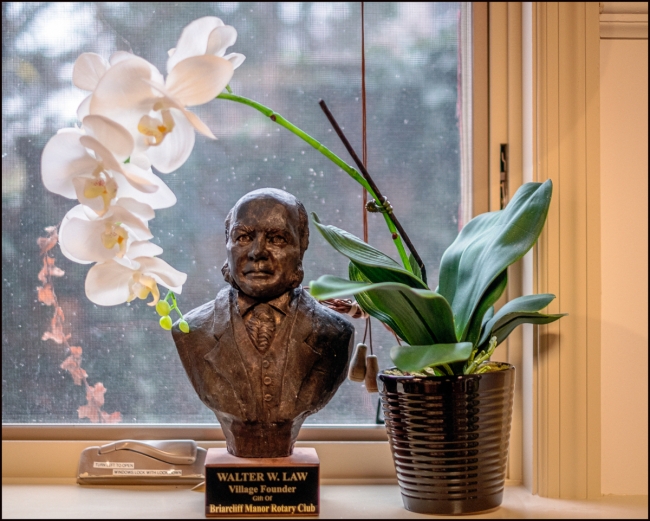I noticed this bust standing on a window sill in the home of the Briarcliff Manor-Scarborough Historical Society (BMSHS): the Eileen O’Connor Weber Historical Center.
The bust depicts the founder of Briarcliff Manor, NY – my village for the past 25 years. He’s a pretty interesting guy.
Walter William Law (November 13, 1837 – January 17, 1924) was a businessman and the founder of the 8,000-person village of Briarcliff Manor, New York. He was a vice president of furniture and carpet retailer W. & J. Sloane, and later founded the Briarcliff Lodge, the Briarcliff Table Water Company, Briarcliff Farms, and the Briarcliff Greenhouses. He founded or assisted in establishing several schools, churches, and parks in the village, and rebuilt its train station in 1906. In the early 1900s, Walter Law was the largest individual landholder in Westchester County.
Walter Law was born in Kidderminster, England, and was one of ten children of a carpet dealer. He relocated to the United States in 1859, where he lived until his death. Throughout his life, he was employed at various places, including at W. & J. Sloane, where he worked for 24 years. After retiring to a house on Scarborough Road in the small community of Whitson’s Corners, New York, he developed the surrounding farmland into a suburban village. (Wikipedia)
Law was primarily responsible for developing much of what became Briarcliff Manor, including the village, schools, churches, parks and the Briarcliff Lodge. He founded the School of Practical Agriculture in 1900 on Pleasantville Road and had invested extensively in the area by 1902. His employees at Briarcliff Farms moved into the village with Law directly holding some of their mortgages. At the time, New York State required a population density of at least 300 per square mile as the first step towards incorporation as a village. A proposition was presented to the supervisors of Mount Pleasant and Ossining on October 8, 1902 that the area of 640 acres (1 sq mi) with a population of 331 be incorporated as the Village of Briarcliff Manor, and was accepted on November 21. At the time, Law owned all but two small parcels of the square mile village and employed 100 of its residents.
At its 1902 opening, the Briarcliff Lodge was a premier resort hotel. Situated on the highest point of Law’s estate, the Tudor-revival -style building was surrounded by dairy barns and greenhouses. In its first decades, the Lodge served mostly as a summer residence for New Yorkers but expanded its year-round appeal through the addition of new rooms, activities and some of the finest chefs in the region. During its time, it hosted numerous distinguished guests, from politicians to movie stars, including Franklin and Eleanor Roosevelt, when he was Governor of New York.
In 1903, Mrs. Dow’s School for Girls was founded at the Briarcliff Lodge; two years later, Walter Law gave Mary Elizabeth Dow 35 acres and built Dow Hall; the school later became known as Briarcliff College. Also established in 1903, the Briarcliff Manor Fire Department was founded on February 10 by Frederick C. Messinger from Briarcliff Manor’s first fire company, the 1901 Briarcliff Steamer Company No. 1. The department’s first fire engine was white, which Messinger thought more visible than the conventional red in a village without street lights, and the village’s engines remain white today. The first twenty-nine street lights, all electric, were installed in 1904. Law largely developed his land as a business corporation until 1907, when Briarcliff Farms moved to Pine Plains, New York, and Law began promoting Briarcliff Manor as a residential development.
Throughout the early 1900’s the population of Briarcliff grew dramatically and increased further with the annexation of Scarborough in 1910. Through the efforts of the Briarcliff Reality Company, residential building flourished, including several large houses built in the vicinity of the Lodge and owned by former guests. Walter Law died in 1924, but expansion of the community continued, including the creation of the Edith Macy Conference Center in 1925 through a gift of 265 acres by V Everit Macy to the Girl Scouts of the USA. A high school was opened in 1928 and a second road race (following the 1908 event) was sponsored by the Automobile Racing Club of American in 1934, stretching over 100 miles and including many of the roads in Briarcliff. (BMSHS website).
Taken with a Fuji X-E1 and Fuji XF 35mm f1.4 R

